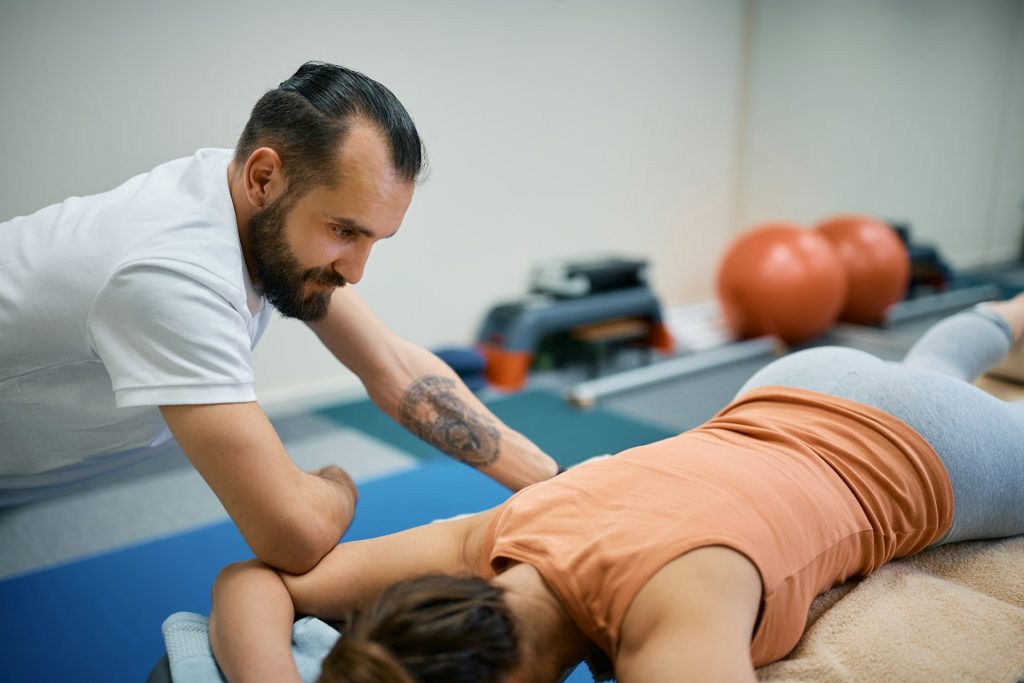Sports massage is a targeted form of therapy that caters specifically to athletes and active individuals, focusing on the areas of the body that are overused and stressed from repetitive and often aggressive movements. It employs various sports massage techniques designed to enhance athletic performance, expedite recovery, and prevent injuries, making it a crucial component in any athlete’s training regimen. Whether you’re a weekend warrior or a professional competitor, sports massage can be tailored to your fitness level and the demands of your sport.
By applying a strategic blend of pressure and movement, sports massage works deep within the muscles, promoting flexibility, reducing fatigue, and improving endurance. This hands-on manipulation of the muscles aids in alleviating muscle tension and soreness, thereby unlocking an athlete’s full potential for peak performance and aiding in swift recovery post-exertion.
Understanding the Basics of Sports Massage
At its core, sports massage aims to prepare the body for optimal performance, maintain it during strenuous activity, and help athletes recover from workouts and injuries. Sports massage techniques can be quite diverse, encompassing a range of strokes and methods to address the unique needs of athletes. These techniques may include kneading, tapping, and long strokes to enhance blood flow and muscle flexibility, essential for pre and post-event recovery.
Defining Sports Massage and Its Primary Goals
Sports massage is defined as a systematic manipulation of the body’s soft tissues that focuses on muscles relevant to a particular sport. The primary goal of sports massage is to alleviate stress and tension, which builds up in the body’s soft tissues during physical activity. By concentrating on specific muscle groups, sports massage helps athletes maintain or improve their range of motion and muscle flexibility, contributing to overall performance and longevity in their sport.
How Sports Massage Differs from Other Massage Therapies
While traditional massage therapies aim to induce relaxation and relieve stress, sports massage is tailored to the needs of athletes. It emphasizes the prevention and healing of injuries to the muscles and tendons and is significantly more vigorous than other forms of massage. It is also distinct in its use of targeted sports massage techniques applied at a pace and intensity that align with an athlete’s training schedule, condition, and sport-specific demands.

Exploring the Benefits of Sports Massage
Sports massage offers a myriad of benefits for athletes, including improved performance, reduced injury risk, and quicker recovery times. These advantages make sports massage an essential part of any serious athlete’s regimen, contributing to longevity and success in their sporting endeavors.
Enhanced Athletic Performance
The application of sports massage techniques before events can stimulate blood flow, increase flexibility, and mentally prepare athletes for peak performance. Following a consistent sports massage routine can also elevate an athlete’s training capacity by enhancing body awareness and movement efficiency. This proactive approach to muscle care can lead to a noticeable improvement in power, endurance, and overall athletic ability.
Injury Prevention and Recovery
Sports massage plays a pivotal role in preventing athletic injuries by maintaining muscle elasticity and flexibility. When injuries occur, sports massage can accelerate the healing process by increasing circulation to the affected area, promoting tissue repair, and reducing recovery time. This helps athletes return to their sport faster and ensures they do so at their full potential.
Accelerated Muscle Recovery and Flexibility
One of the most appreciated benefits of sports massage is its ability to speed up muscle recovery. By stimulating blood flow to fatigued and sore muscles, sports massage facilitates the removal of lactic acid and other metabolic wastes. The result is a faster return to training, enhanced flexibility, and reduced muscle soreness, collectively contributing to a more effective and enjoyable athletic experience.
When to Seek Sports Massage
Integrating sports massage into your training program should be strategic; knowing when to seek out this therapy can make a significant difference in its effectiveness and your athletic performance.
Optimal Timing for Maximum Effectiveness
Timing is key to reaping the maximum benefits of sports massage. Pre-event massages are best scheduled a few days before the event to optimize muscle function and enhance performance. Post-event massages should be aimed at reducing muscle spasms and metabolic build-up that occurs with vigorous exercise. For maintenance, having a sports massage every week or two may help prevent injuries and sustain peak muscle condition.
Pre-Event Preparation
Before a competition or major workout, a sports massage can prepare your body for the upcoming physical stress. It warms up the muscles, ensuring optimized blood flow, which can enhance your flexibility and performance. This proactive approach not only primes your muscles for exertion but can also calm nerves, giving you a competitive edge.
Post-Event Recovery
Following an event, sports massage is invaluable in aiding the body’s recovery process. It helps to flush out toxins, reduce muscle stiffness, and restore normal muscle condition more swiftly. This form of massage can significantly expedite the healing process, allowing for a quicker return to training and competition.
Routine Maintenance for Athletes
Regular sports massage is crucial for maintaining the health of an athlete’s soft tissues. It can incorporate trigger point therapy to manage muscle tightness and alleviate pain, ensuring that the muscles and tendons remain in prime condition. This ongoing care is essential for preventing injuries and ensuring continuous improvement in athletic performance.
The Experience of Receiving Sports Massage
Receiving a sports massage can be rejuvenating and intense, as it involves techniques that target muscle groups with precision and firm pressure. It’s a specialized experience that optimizes your body’s ability to perform and recover.
Is Sports Massage Supposed to Be Painful?
While sports massage can be intense, it should not cause unbearable pain. It’s common to feel discomfort as the therapist works through tight muscles or trigger points. However, effective communication between you and your massage therapist is key to ensuring the pressure is therapeutic, not torturous. The goal is to find the sweet spot where the massage effectively promotes recovery and improves function without causing additional pain.
Common Sensations and What to Expect During Treatment
During a sports massage session, you might feel various sensations as the therapist works to relieve pain and tension in your muscles and connective tissues. Expect a combination of deep pressure, kneading, and circular movements to reduce muscle tension and promote muscle relaxation. You may experience temporary discomfort as tight muscles are worked on, but this is part of the process to achieve decreased tension and quicker recovery from exercise.

Comparing Sports Massage With Deep Tissue Therapy
While both sports massage and deep tissue massage treat musculoskeletal issues and target the deeper layers of muscle, they serve different purposes. Deep tissue massage focuses on chronic pain and the release of tight muscles, whereas sports massage is tailored to the needs of athletes. The techniques in sports massage are often more dynamic and can include both active and passive movements specifically designed for those with an active lifestyle.
Sports Massage Versus Deep Tissue Massage: Key Differences
Sports massage therapy differs from deep tissue massage in its goals and methods. Sports massage is an effective treatment for muscle strains and sports injuries, often incorporating stretches and techniques specific to the athlete’s sport. It emphasizes the prevention of injuries and enhancing performance through improved flexibility and decreased muscle tension.
On the other hand, deep tissue massage is more focused on relieving muscle tension and breaking down scar tissue to provide pain relief, especially for those with chronic pain from repetitive movements.
Final Thoughts
The benefits of sports massage extend beyond mere relaxation, offering enhanced athletic performance and a treatment plan for aches and pains. Sports massage is safe with its focus on the specific needs of muscles and joints. It can be a vital component of an athlete’s regimen, helping to ensure an optimal balance of strength, flexibility, and endurance for both amateur and professional athletes.
